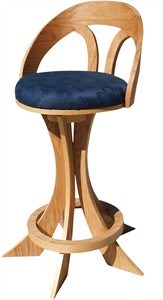
This undated publicity product photo, a Bespoke chair, crafted in part from white oak plywood, and featured in "PlyDesign," by Philip Schmidt, is shown. Plywood is versatile, inexpensive and easy to come by. You can find standard, seven-ply plywood at your home-improvement store (and higher-quality plywood at your local lumber center). (AP Photo/ Storey Publishing, Kristin Hare)
January 08, 2013 - 7:57 AM
The home-improvement and design shows make it look easy: Take a simple sheet of inexpensive plywood and presto! In a few minutes, you've got a table, a cabinet or a lounge chair.
It's not that fast or dirt-cheap, but it can be that easy, according to woodworking experts who speak fondly of plywood's many merits.
"Plywood is the starting point for many of the things I build," says artist and designer Jimmy DiResta of New York City. "With some imagination and inventiveness it can become anything."
Plywood is cheaper and often stronger than solid wood, easy to find at home-improvement or lumber stores, and — darn it — it looks good.
Plywood is made from thin layers — called plies, or veneers — glued together under heat and pressure, with each ply laid perpendicular to the next. This "cross-graining" gives plywood its strength and stability, says Philip Schmidt, author of "PlyDesign" (Storey Publishing, 2012).
Since plywood comes in more than a dozen standard thicknesses and twice as many grades, check a buying guide — Home Depot has one online — before purchasing it. Schmidt recommends using a cabinet-grade material, such as Baltic birch, for do-it-yourself projects. The plies are thin and even, and the exterior is smooth, sanded and blemish-free.
"Beluga caviar notwithstanding, Baltic birch plywood may be Russia's finest export," Schmidt writes in his book.
"PlyDesign" includes 73 projects for novices and experienced builders. Do-it-yourself project magazines such as Ready Made and Make, and online sites such as Instructables offer many other ways to use plywood.
"Plywood is inherently modern, if you think of modern as starting in the 1920s," says Schmidt, of Denver. "It's still beautiful wood . and it's really easy to work with."
A jigsaw can cut straight lines and curves, so that's your primary tool, says Schmidt. After that, invest in a good-quality drill. If you want to go deeper into plywood DIY, get a circular saw and a router, which helps cut out multiple pattern pieces.
"I don't own a table saw or any stationary power tools," says Schmidt, a project designer and author of 17 design books. "I'm more into DIY."
DiResta recommends the jigsaw and circular saw for most plywood projects, and suggests starting out by building a storage box or simple bench. He offers video tutorials on YouTube, sponsored by Make magazine.
Plywood has its drawbacks. Schmidt warns against sand-papering through the thin top layer, ruining the look of your piece. To avoid this, use a fine-grit sandpaper, and be careful.
DiResta warns against splinters. A few years ago, he inadvertently brushed a palm against a cut edge, and a matchstick-size splinter went through his palm. He recommends wearing gloves when cutting plywood, and sanding cut edges with a sanding block.
Then there's "the edge thing," as Schmidt calls it: Do you cover the exposed plywood edge or let it be?
Design will dictate, both DiResta and Schmidt say. Some modern-looking pieces look great with their plywood edges exposed, and the better quality the plywood, the better it'll look. For other projects, you may want to cover that edge with veneer.
"Exposing the edge strata of the panel is really cool," says Schmidt. "It's a nice design element that you can work with."
For some, a project is too delicate or the plywood too high-end to entrust the cutting to one's own hand. If that happens, find a local furniture-design business to cut the piece for you. They use computer-controlled routers that make precise cuts.
Denver furniture maker Scott Bennett works with birch-and-alder plywood to make storage and shelving pieces for his company, Housefish. Occasionally, he's asked to cut a one-off piece for a designer or DIY enthusiast.
The cost is less than most people expect, he says, averaging about $100 per hour of work.
"Considering how many hours you might spend trying to cut a complicated shape with hand tools . spending a couple hundred dollars to have a computer cut out your parts can be a good way to get into DIY projects," Bennett says.
He recommends investigating the online site Ponoko, which provides laser-cutting services, but says most cities will have a few businesses that can handle an outside precision-cutting job.
___
Online:
http://www.youtube.com/user/jimmydiresta
http://www.philipschmidt.net
http://housefish.com
https://www.ponoko.com
http://www.readymade.com
http://makezine.com
News from © The Associated Press, 2013